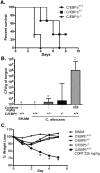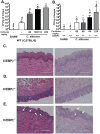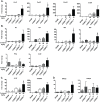C/EBPβ Promotes Immunity to Oral Candidiasis through Regulation of β-Defensins
- PMID: 26317211
- PMCID: PMC4552893
- DOI: 10.1371/journal.pone.0136538
C/EBPβ Promotes Immunity to Oral Candidiasis through Regulation of β-Defensins
Abstract
Humans or mice subjected to immunosuppression, such as corticosteroids or anti-cytokine biologic therapies, are susceptible to mucosal infections by the commensal fungus Candida albicans. Recently it has become evident that the Th17/IL-17 axis is essential for immunity to candidiasis, but the downstream events that control immunity to this fungus are poorly understood. The CCAAT/Enhancer Binding Protein-β (C/EBPβ) transcription factor is important for signaling by multiple inflammatory stimuli, including IL-17. C/EBPβ is regulated in a variety of ways by IL-17, and controls several downstream IL-17 target genes. However, the role of C/EBPβ in vivo is poorly understood, in part because C/EBPβ-deficient mice are challenging to breed and work with. In this study, we sought to understand the role of C/EBPβ in the context of an IL-17-dependent immune response, using C. albicans infection as a model system. Confirming prior findings, we found that C/EBPβ is required for immunity to systemic candidiasis. In contrast, C/EBPβ(-/-) mice were resistant to oropharyngeal candidiasis (OPC), in a manner indistinguishable from immunocompetent WT mice. However, C/EBPβ(-/-) mice experienced more severe OPC than WT mice in the context of cortisone-induced immunosuppression. Expression of the antimicrobial peptide β-defensin (BD)-3 correlated strongly with susceptibility in C/EBPβ(-/-) mice, but no other IL-17-dependent genes were associated with susceptibility. Therefore, C/EBPβ contributes to immunity to mucosal candidiasis during cortisone immunosuppression in a manner linked to β-defensin 3 expression, but is apparently dispensable for the IL-17-dependent response.
Conflict of interest statement
Figures




Similar articles
-
Interleukin-17-induced protein lipocalin 2 is dispensable for immunity to oral candidiasis.Infect Immun. 2014 Mar;82(3):1030-5. doi: 10.1128/IAI.01389-13. Epub 2013 Dec 16. Infect Immun. 2014. PMID: 24343647 Free PMC article.
-
Th17 cells and IL-17 receptor signaling are essential for mucosal host defense against oral candidiasis.J Exp Med. 2009 Feb 16;206(2):299-311. doi: 10.1084/jem.20081463. Epub 2009 Feb 9. J Exp Med. 2009. PMID: 19204111 Free PMC article.
-
Role of neutrophils in IL-17-dependent immunity to mucosal candidiasis.J Immunol. 2014 Feb 15;192(4):1745-52. doi: 10.4049/jimmunol.1302265. Epub 2014 Jan 17. J Immunol. 2014. PMID: 24442441 Free PMC article.
-
Perspective on receptor-associated immune response to Candida albicans single and mixed infections: Implications for therapeutics in oropharyngeal candidiasis.Med Mycol. 2023 Aug 2;61(8):myad077. doi: 10.1093/mmy/myad077. Med Mycol. 2023. PMID: 37533203 Review.
-
Immunity to Candida.Oral Dis. 2002;8 Suppl 2:69-75. doi: 10.1034/j.1601-0825.2002.00015.x. Oral Dis. 2002. PMID: 12164664 Review.
Cited by
-
Targeting Th17 cells: a promising strategy to treat oral mucosal inflammatory diseases.Front Immunol. 2023 Jul 26;14:1236856. doi: 10.3389/fimmu.2023.1236856. eCollection 2023. Front Immunol. 2023. PMID: 37564654 Free PMC article. Review.
-
[Progress on the role of Toll-like receptors in Candida albicans infections].Zhejiang Da Xue Xue Bao Yi Xue Ban. 2016 May 25;45(3):302-7. doi: 10.3785/j.issn.1008-9292.2016.05.14. Zhejiang Da Xue Xue Bao Yi Xue Ban. 2016. PMID: 27651197 Free PMC article. Chinese.
-
Candida albicans Modulates Murine and Human Beta Defensin-1 during Vaginitis.J Fungi (Basel). 2021 Dec 28;8(1):20. doi: 10.3390/jof8010020. J Fungi (Basel). 2021. PMID: 35049960 Free PMC article.
-
Single-cell RNA-Seq reveals the transcriptional landscape and heterogeneity of skin macrophages in Vsir-/- murine psoriasis.Theranostics. 2020 Aug 21;10(23):10483-10497. doi: 10.7150/thno.45614. eCollection 2020. Theranostics. 2020. PMID: 32929361 Free PMC article.
-
The Kallikrein-Kinin System: A Novel Mediator of IL-17-Driven Anti-Candida Immunity in the Kidney.PLoS Pathog. 2016 Nov 4;12(11):e1005952. doi: 10.1371/journal.ppat.1005952. eCollection 2016 Nov. PLoS Pathog. 2016. PMID: 27814401 Free PMC article.
References
-
- Acosta-Rodriguez EV, Rivino L, Geginat J, Jarrossay D, Gattorno M, Lanzavecchia A, et al. Surface phenotype and antigenic specificity of human interleukin 17-producing T helper memory cells. Nat Immunol. 2007;8:639–46. - PubMed
Publication types
MeSH terms
Substances
Grants and funding
LinkOut - more resources
Full Text Sources
Other Literature Sources
Molecular Biology Databases

